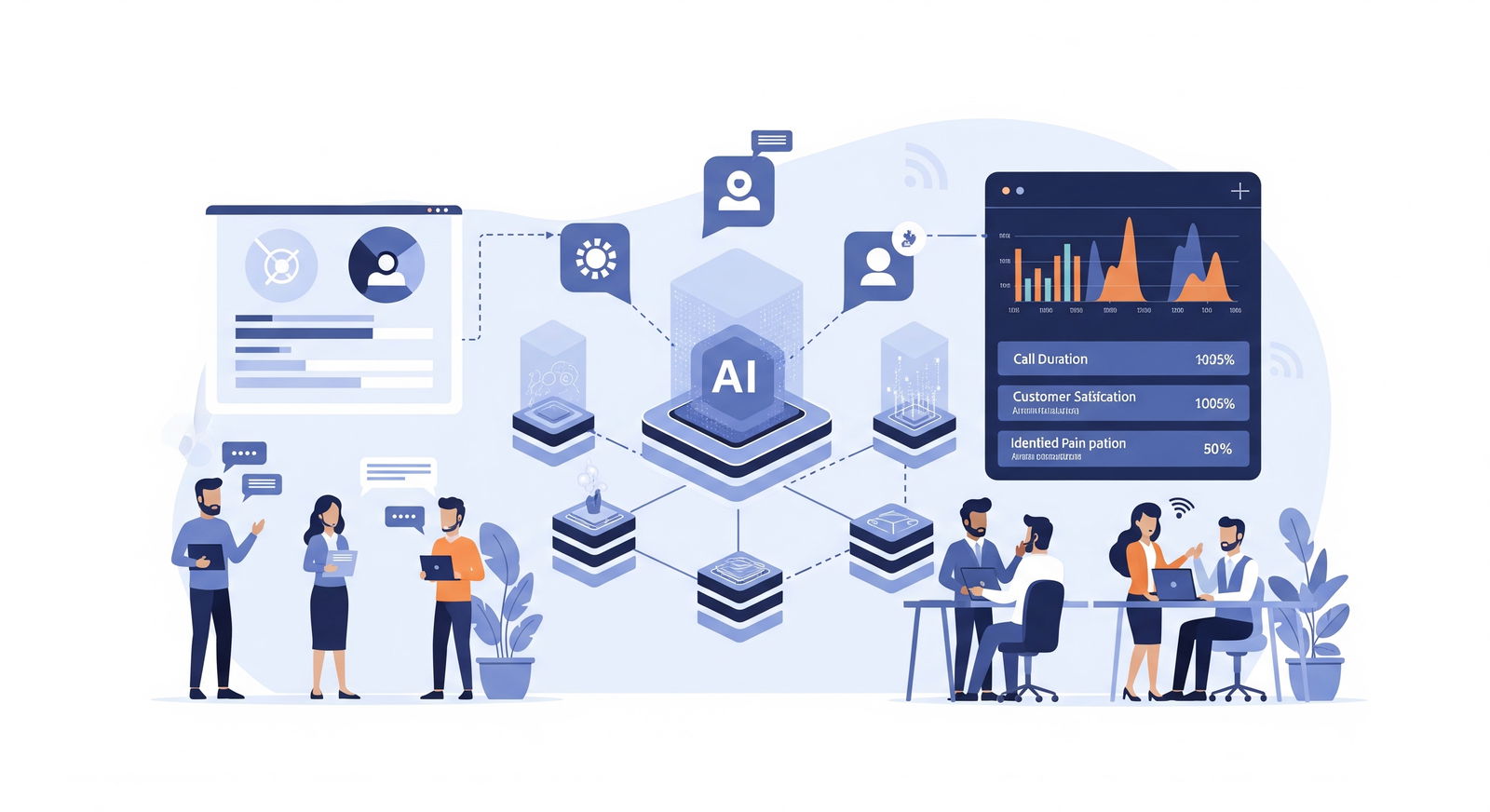
Automating call analysis to improve customer service
Table of contents
Quick Access

In the age of hyperpersonalization, where 80% of consumers expect consistent and contextualized service (according to Salesforce), companies are reevaluating how they interact with their customers.
Today more than ever, optimizing the user experience is not only a competitive advantage, but a critical necessity for business sustainability.
In this context, automated call analytics using Artificial Intelligence (AI) has emerged as a powerful solution that transforms customer service into a strategic asset.
Thanks to real-time data processing, companies can now extract value from every conversation, detect patterns, and make informed decisions to continuously improve their services.

Call analytics as a goldmine of data
Every phone interaction with a customer is a rich source of insights: from emotions and frustrations to unmet needs and business opportunities. However, in an environment where an average company can receive thousands of calls per month, manual analysis is unfeasible and expensive.
This is where natural language processing (NLP) technologies, real-time speech-to-text, and machine learning algorithms come into play, enabling large-scale voice analysis automation. These solutions not only streamline operational workflows but also eliminate human bias and improve the quality of internal diagnostics.
According to Gartner, by 2026, 75% of organizations operating contact centers will use AI to analyze customer interactions, up from 30% in 2023. The shift is already underway.
Tangible benefits of AI-Powered data analysis
Implementing AI-powered call analytics isn't just a matter of efficiency: it's a direct path to improving organizational performance. Among the main benefits are:
- Real-time monitoring: AI-powered platforms instantly transcribe calls, extract keywords, and detect emotions such as anger, satisfaction, or anxiety using sentiment analysis models.
- Detection of emerging trends: By analyzing thousands of conversations, recurring patterns are identified that anticipate crises, reveal new consumer expectations, or inspire new product development.
- Objective performance evaluation: Supervisory teams access dashboards with behavioral metrics such as response times, tone of voice, interruptions, and first call resolution (FCR).
- Improved customer experience (CX): By predicting problems and offering more accurate and empathetic responses, user satisfaction increases and churn is reduced.
In fact, a McKinsey study indicates that Companies that integrate AI into customer service can reduce their operating costs by up to 30%, while increasing customer satisfaction by up to 20 percentage points.
Key data processing tools applied to call analysis
The evolution of the customer service technology stack has enabled greater integration between channels, AI, and predictive analytics. The most advanced solutions incorporate features such as:
- Advanced Speech-to-Text: Transforms conversations into text in real time with high accuracy, facilitating searches, audits, and compliance.
- Sentiment Analysis: Detects emotions and attitudes in the customer's voice using models trained in real-life linguistic contexts.
- Conversational AI: Optimizes responses from virtual and human agents by suggesting phrases, redirecting conversations, and preventing conflicts.
- CRM Integration: Merges conversational data with customer history, creating enriched, personalized profiles.
- Conversational Intelligence Dashboards: Centralize critical indicators for customer experience leaders, such as NPS, CSAT, average resolution time, or response rate. scaling.
Companies like Rootstack, specialists in developing custom AI solutions, are integrating these tools to build agile, user-centric conversational ecosystems.

Use cases by industry
Automated call analysis is already being successfully applied in multiple sectors, demonstrating its adaptability and return on investment (ROI):
- Banking and insurance: Identification of fraud attempts through analysis of tone of voice and linguistic patterns. Improve digital onboarding with real-time assistance.
- Retail and e-commerce: Detection of friction in the purchasing process, campaign optimization, and post-sales support with AI.
- Telecommunications: Churn prevention through early alerts based on repeated complaints and improved technical ticket management.
- Healthcare: Detection of medical emergencies and automatic call categorization to streamline the response of clinical teams.
In addition, companies like Rootstack have collaborated with organizations in these sectors to develop intelligent chatbots and virtual assistants that complement call analytics platforms, achieving a fully automated 360° customer service experience.
How to start a call analytics project with AI
Successfully implementing such a solution requires a clear roadmap. The recommended steps are:
- Define strategic objectives: Are you looking to improve customer service KPIs, increase retention, or identify business opportunities?
- Select the right technology: Speech analytics, NLP, conversational AI... it's vital that the tool integrates with your current systems (CRM, ERP, etc.).
- Have a solid technology partner: Companies like Rootstack, with proven experience integrating AI solutions, accelerate implementation and reduce risk.
- AI model training: Use historical call data to adapt algorithms to your specific business context.
- Monitoring and continuous improvement: Establish clear KPIs, measure the impact, and adjust the model periodically.

Beyond analytics: the new strategic role of processing Data analytics
Automating call analysis is no longer a futuristic option, but a key element in the evolution of the customer service model. Data processing allows each call to cease being an isolated event and become a valuable input for business decision-making.
With a customer-centric view and well-implemented AI tools, organizations can:
- Anticipate churn behaviors
- Identify cross-selling and upselling opportunities
- Improve agent productivity by up to 40% (according to PwC)
- Build stronger, more personalized relationships
In an environment where every experience counts, technology is redefining what it means to deliver excellent customer service. Automating call analysis with AI and data processing not only increases operational efficiency but also strengthens data-driven decision-making, which in turn drives loyalty, innovation, and competitiveness.
With partners like Rootstack, experts in AI chatbot development, automation, and predictive analytics, the leap toward smarter, more efficient, and customer-centric service is more accessible than ever.
Are you ready to turn every call into a strategic advantage? Contact us!
We recommend you this video
Related blogs

Microservices architecture: Designing scalable systems

How an MCP works explained for CEOs: the Host–Client–Server model without technical jargon

The cost of not adopting an MCP standard for AI by 2026: risks and inefficiencies

Real-world examples of MCP: from customer support to process automation

What is a Model Context Protocol (MCP) and why will it shape the future of enterprise AI?
